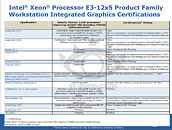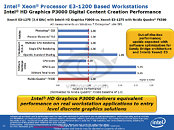- Joined
- Oct 9, 2007
- Messages
- 47,485 (7.49/day)
- Location
- Hyderabad, India
| System Name | RBMK-1000 |
|---|---|
| Processor | AMD Ryzen 7 5700G |
| Motherboard | ASUS ROG Strix B450-E Gaming |
| Cooling | DeepCool Gammax L240 V2 |
| Memory | 2x 8GB G.Skill Sniper X |
| Video Card(s) | Palit GeForce RTX 2080 SUPER GameRock |
| Storage | Western Digital Black NVMe 512GB |
| Display(s) | BenQ 1440p 60 Hz 27-inch |
| Case | Corsair Carbide 100R |
| Audio Device(s) | ASUS SupremeFX S1220A |
| Power Supply | Cooler Master MWE Gold 650W |
| Mouse | ASUS ROG Strix Impact |
| Keyboard | Gamdias Hermes E2 |
| Software | Windows 11 Pro |
While its processor-integrated graphics solutions may not be a match for those from NVIDIA and AMD in terms of client applications such as gaming, Intel thinks it has a shot at the entry-level workstation graphics segment, dominated by the likes of NVIDIA Quadro FX 580 and AMD FirePro V3800 series. Workstation GPUs differ from consumer ones as they are accompanied by more API features, are certified by professional 3D modelling software, and are designed to minimize rendering errors since these renders go on to take shape as millions of dollars worth skyscrapers, for example.
Intel thinks that after the performance success of SNA, it has achieved an acceptable level of performance with its integrated graphics design to take it professional. It is doing so by creating workstation-variants of the "Sandy Bridge" and future "Ivy Bridge" silicons in the Xeon E3-1200 series, and giving their integrated graphics increased functionality. The result is a variant of Intel's HD graphics 3000 series, called Intel HD Graphics P3000 series (P denoting professional). Intel is applying for certification by 3D modeling software developers (it's important, because engineers look for these certifications before picking their hardware). The status of its certification with various vendors is detailed in the first slide below.


The next slide (above) details Intel's own performance measurements in applications such as Adobe Photoshop, Cinebench 11.5 R2, and 3DMark Vantage, with various sub-tests. NVIDIA's entry-level Quadro FX 580 was used as a baseline. The HD P3000 scored on-par and outperformed the Quadro FX 580 in all these tests, which is a good feat, considering using the HD P3000 instead of FX 580 results in a $180 saving.
View at TechPowerUp Main Site
Intel thinks that after the performance success of SNA, it has achieved an acceptable level of performance with its integrated graphics design to take it professional. It is doing so by creating workstation-variants of the "Sandy Bridge" and future "Ivy Bridge" silicons in the Xeon E3-1200 series, and giving their integrated graphics increased functionality. The result is a variant of Intel's HD graphics 3000 series, called Intel HD Graphics P3000 series (P denoting professional). Intel is applying for certification by 3D modeling software developers (it's important, because engineers look for these certifications before picking their hardware). The status of its certification with various vendors is detailed in the first slide below.


The next slide (above) details Intel's own performance measurements in applications such as Adobe Photoshop, Cinebench 11.5 R2, and 3DMark Vantage, with various sub-tests. NVIDIA's entry-level Quadro FX 580 was used as a baseline. The HD P3000 scored on-par and outperformed the Quadro FX 580 in all these tests, which is a good feat, considering using the HD P3000 instead of FX 580 results in a $180 saving.
View at TechPowerUp Main Site






 And this is going to be built in.
And this is going to be built in.
 They must buy Matrox or another company who has a ton of patents and innovations in the picture quality aspect of the GPU or else more and more people will be forced to use their GPUs who represent pictures horribly on the screen. Matrox would be the perfect candidate to give their graphics division a much needed boost...
They must buy Matrox or another company who has a ton of patents and innovations in the picture quality aspect of the GPU or else more and more people will be forced to use their GPUs who represent pictures horribly on the screen. Matrox would be the perfect candidate to give their graphics division a much needed boost...